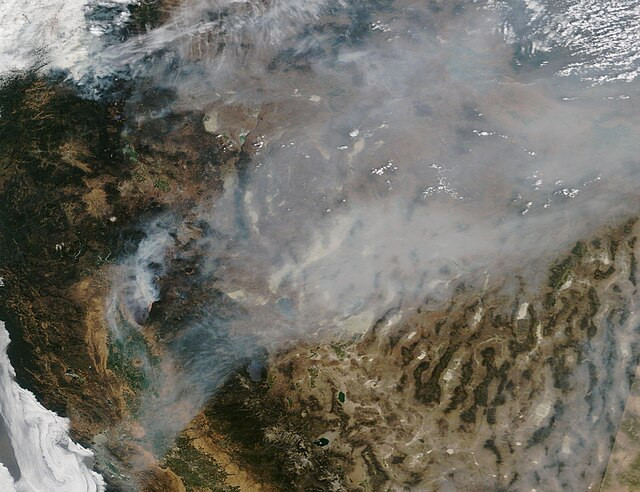California's Park Fire has surged to become the fifth largest wildfire in the state's recorded history, engulfing 383,619 acres as of Tuesday morning, according to Cal Fire. The massive blaze, which ignited in Chico's Bidwell Park on July 24, continues to pose significant challenges despite a slight increase in containment from 12% to 14%. More evacuations were lifted on Monday, but many areas around the fire's perimeter remain active, with spot fires complicating efforts to control the blaze.
Firefighters are concentrating their efforts on the fire's eastern side, particularly along a stretch of the Highway 32 corridor at Humboldt Road, just north of Forest Ranch. "In that area, we had a massive slop over," said Edwin Zuniga, a Cal Fire spokesperson. "The fire went over the highway and burned 150 acres. With the winds picking up today, the fire might continue to grow. We're trying to get in there as fast as possible and contain that 150 acres that we lost."
The fire, which has been fueled by high temperatures, dry conditions, and strong winds, has resulted in the evacuation of 26,000 people across Butte, Plumas, Shasta, and Tehama counties. As of Monday, 165 structures have been destroyed, and 4,200 remain threatened. The Park Fire's rapid spread has been somewhat slowed by cooler temperatures and higher humidity over the weekend, but a forecasted warmup and winds up to 15 mph could worsen conditions.
Governor Gavin Newsom has declared a state of emergency for Butte and Tehama counties, facilitating easier access to unemployment benefits and waiving fees for replacing essential documents like driver's licenses and birth certificates. The Butte County public health officer has also declared a local health emergency due to hazardous materials found in the fire's ash and debris, allowing the county to access programs to remove toxic substances from destroyed properties.
The Park Fire's current size surpasses the 2020 Creek Fire in Fresno and Madera counties, which burned 379,895 acres, making it the fifth-largest in California's history. The fire's perimeter, at 260 miles, has burned more than three times the surface area of Lake Tahoe. Most of the scorched land, approximately 330,515 acres, is in Tehama County, with the remaining 53,104 acres in Butte County.
Efforts to combat the fire involve over 5,300 personnel, an increase from 4,800 on Monday. Despite the increase in resources, the fire continues to burn actively in several locations, with southwestern winds posing a significant challenge. "This fire has lots of fuel that is receptive to burning, and it's hard to get to," said Fire Capt. Dan Collins of Cal Fire. "Our fire line is 260 miles around, that's the size of three Lake Tahoes. It can take two-three hours to get personnel in there over the terrain."
Evacuation orders and warnings remain in effect across parts of Butte, Tehama, Shasta, and Plumas counties. In Butte County, evacuation warnings near Chico and Forest Ranch have been lifted, as well as for the town of Paradise, which was devastated by the 2018 Camp Fire. However, due to increased fire activity in Shasta County, some evacuation orders and warnings were upgraded.
Shelters have been established for evacuees in several counties. In Butte County, an evacuation center is set up at Neighborhood Church in Chico, with shelters for small and large animals also available. Tehama County has a Red Cross evacuation center at Los Molinos Vet's Hall and additional shelters for animals. In Shasta County, an evacuation center is located at Bella Vista Elementary School.
The fire is believed to have been caused by arson. Ronnie Dean Stout II, a 42-year-old man from Chico, has been arrested and charged with starting the fire by pushing his mother's burning car into a gully in upper Bidwell Park. Stout, who has previous convictions, appeared in court on Monday but did not enter a plea and was denied bail.
The Park Fire is the largest wildfire in the U.S. this year, surpassing the size of the 2020 Creek Fire. The fire's rapid expansion and the severe conditions it has created highlight the ongoing challenges California faces with wildfires, particularly as climate conditions continue to exacerbate the frequency and intensity of such events.






